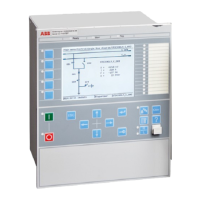Only detailed network studies can determine the operating conditions under which the
highest possible fault current is expected on the line. In most cases, this current appears
during three-phase fault conditions. But also examine single-phase-to-earth and two-phase-
to-earth conditions.
Also study transients that could cause a high increase of the line current for short times. A
typical example is a transmission line with a power transformer at the remote end, which can
cause high inrush current when connected to the network and can thus also cause the
operation of the built-in, instantaneous, overcurrent protection.
GlobalBaseSel
: Selects the global base value group used by the function to define (
IBase
),
(
UBase
) and (
SBase
).
OpMode
: This parameter can be set to
2 out of 3
or
1 out of 3
. The setting controls the
minimum number of phase currents that must be larger than the set operate current
IP>>
for
operation. Normally this parameter is set to
1 out of 3
and will thus detect all fault types. If the
protection is to be used mainly for multi phase faults,
2 out of 3
should be chosen.
IP>>
: Set operate current in % of
IBase
.
StValMult
: The operate current can be changed by activation of the binary input ENMULT to
the set factor
StValMult
.
IP>>MinEd2Set
: Minimum settable operate phase current level in % of IBase, for IEC 61850 Ed.
2 settings.
IP>>MaxEd2Set
: Maximum settable operate phase current level in % of IBase, for IEC 61850 Ed.
2 settings.
7.1.3.1 Meshed network without parallel line
M12915-9 v7
The following fault calculations have to be done for three-phase, single-phase-to-earth and
two-phase-to-earth faults. With reference to figure
39, apply a fault in B and then calculate the
current through-fault phase current I
fB
. The calculation should be done using the minimum
source impedance values for Z
A
and the maximum source impedance values for Z
B
in order to
get the maximum through fault current from A to B.
~
~
Z
A
Z
B
Z
L
A B
IED
I
fB
Fault
IEC09000022-1-en.vsd
IEC09000022 V1 EN-US
Figure 39: Through fault current from A to B: I
fB
Then a fault in A has to be applied and the through fault current I
fA
has to be calculated,
figure
40. In order to get the maximum through fault current, the minimum value for Z
B
and
the maximum value for Z
A
have to be considered.
Section 7 1MRK 511 358-UEN A
Current protection
102
Application manual

